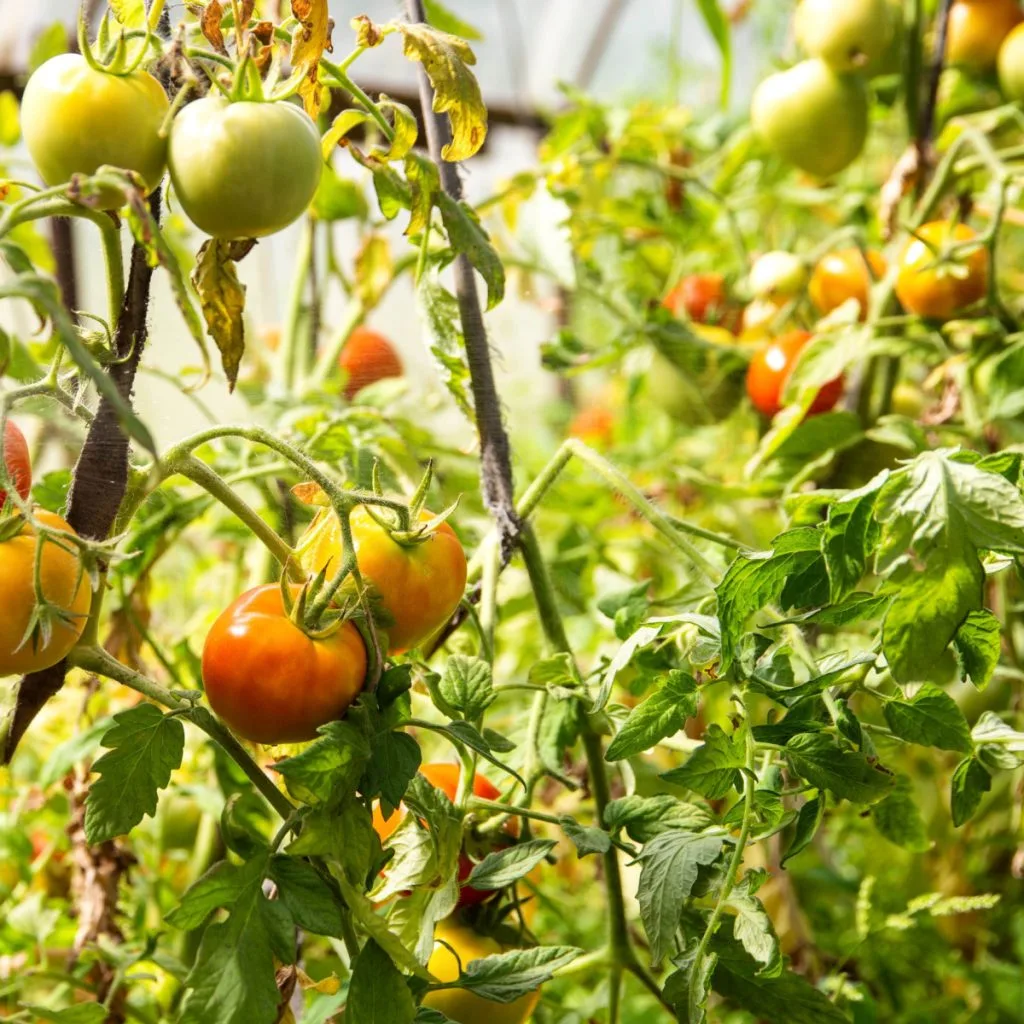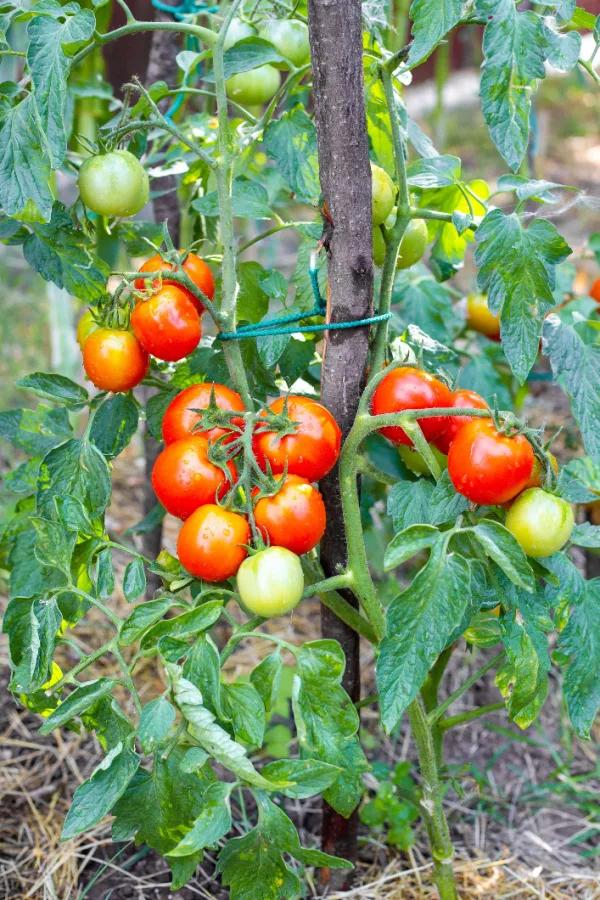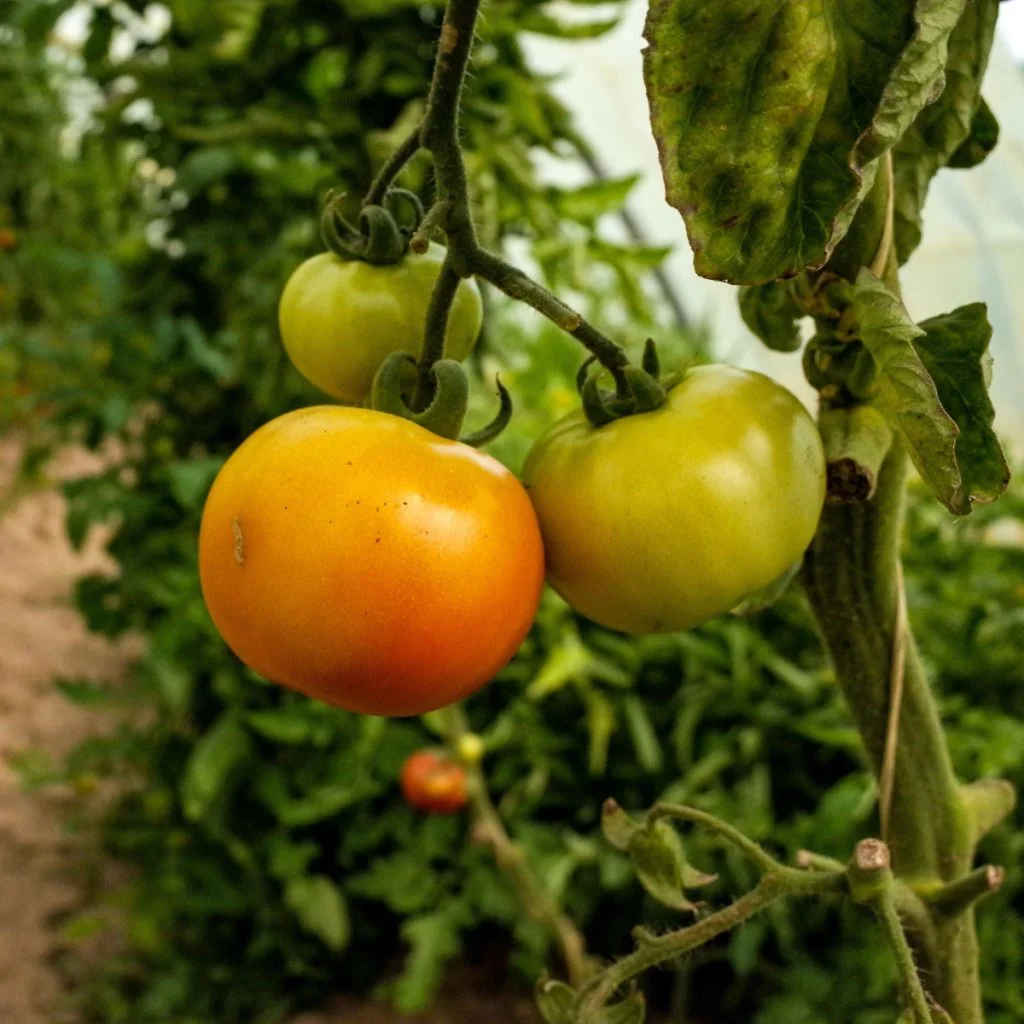Looking for the best way to revive and recharge those tired looking tomato plants growing in your garden or containers late this summer?
By late summer, even the healthiest and most productive indeterminate tomato plants can start to slow down. After spending months producing blooms and ripening fruit, plants often begin to look worn out. Leaves turn yellow, lower stems dry up, and fruit production slows.
But just because the plants are looking tired doesn’t mean the harvest is over. With a few simple late-season care steps, you can breathe new life into those tomato plants and keep them producing right up until the first frost!

How To Revive Tired Tomato Plants
Why Tomato Plants Lose Vigor in Late Summer
Unlike determinate tomatoes, indeterminate tomato plants are designed to keep growing and producing fruit until frost kills them. However, by the time late summer arrives, they’ve often put in a lot of effort. Months of producing flowers, setting fruit, and fighting off pests and disease take a toll.
Several factors contribute to late-season slowdown. Plants can start to struggle in late summer for a few different reasons.
The most common is simply a lack of energy. Over time, they use up much of the nutrients in the soil that fuel their growth and fruit production. Without fresh nutrients being added back, the plants simply run out of the energy they need to keep producing.
The heat of mid to late summer also adds stress. Especially when water or nutrients are not supplied consistently. As plants become bushier, the lower leaves and old branches can block airflow. This poor circulation not only makes them more vulnerable to disease but also reduces their ability to absorb sunlight.
Even More Issues…
Last but not least, another common problem by late summer is fruit overload. When too many ripening tomatoes are left on the plant at once, the plant focuses all its energy on ripening those fruits. And it leaves little strength for producing new blooms and setting additional fruit.

Fortunately, all of these issues can be addressed with the right care techniques. The key is to give them the right nutrients at the right time, improve airflow and plant health by pruning – and stay on top of harvesting so plants don’t become overburdened. And here’s how to do just that!
Fertilizing Tomato Plants In Late Summer
One of the fastest ways to revive tired tomato plants in late summer is to feed them with a balanced but targeted nutrient boost. At this point in the season, your goal isn’t to encourage more foliage growth – it’s to keep plants producing flowers and ripening fruit. That means focusing on phosphorus and potassium, not nitrogen.
Nitrogen is great early in the season for strong leaf and stem growth, but too much nitrogen now will cause plants to push out green foliage at the expense of blooms and fruit. Phosphorus helps with strong root systems and better flower production, while potassium improves fruit size, quality, and ripening speed.
Look for a water-soluble liquid fertilizer with a lower nitrogen number and higher middle (phosphorus) and last (potassium) numbers in its N-P-K ratio. Ideally, you want around twice the amount of phosphorus and potassium. Affiliate Link: Farmer’s Secret Tomato Booster Fertilizer (32oz) – Super Concentrated – 3:8:7 Ratio
Applying Fertilizer In Late Summer
Instead of feeding a large dose all at once, give plants a half-strength dose every 5 to 7 days. This steady feeding provides a consistent supply of nutrients without overwhelming plants. A big one-time dose doesn’t always help because the nutrients leach away before the plant can use them fully.
For example, if the label says to use 1 tablespoon of fertilizer per gallon of water, cut that to ½ tablespoon per gallon. Water the base of each plant slowly. Make sure the solution soaks down to the roots. Avoid getting the liquid on the foliage to reduce the risk of disease.
By feeding regularly and lightly, you keep plants energized and ready to keep producing right through the last weeks of the season.
Pruning For Better Airflow & Plant Health
As tomato plants grow, their lower leaves and older branches begin to yellow and die back. Leaving this foliage in place can reduce airflow, shade out new growth. It can also create a humid environment that invites fungal diseases. Late summer is the perfect time to do some selective pruning to help plants recover.

Begin by removing all of the dead, yellowing, or diseased leaves from the bottom 12 inches of the plant. This area is often the first to show signs of stress, and clearing it helps air circulate freely. A clean lower section also allows sunlight to reach the soil, which can help keep it drier and less hospitable to disease.
If you notice stems that no longer have flowers or fruit forming, trim them out. This redirects the plant’s energy to newer, more productive branches. Always use clean, sharp pruners, and disinfect them between plants to avoid spreading disease.
This type of late-season pruning not only refreshes plants but can also help them bounce back with a burst of new growth and flowers.
Avoiding Fruit Overload To Help Revive Tomato Plants
One of the easiest ways to slow a tomato plant’s production is to let too much ripening fruit remain on the vine at once. When plants have to direct all of their energy into ripening dozens of tomatoes, they stop producing new flowers.
Make a habit of harvesting tomatoes as soon as they start to blush. Blushing is the first sign of color change from green to yellow, orange, or red, depending on the variety. Once a tomato reaches this stage, it no longer needs to stay on the vine to ripen. See our article: How To Know When To Harvest A Tomato – The Answer Might Surprise You!

Picking at the blush stage reduces the plant’s workload, freeing it to send energy into producing more flowers and setting new fruit. It also reduces the risk of damage from pests or sudden weather changes, since ripening tomatoes left on the vine are more vulnerable to cracking, rot, and chewing insects.
Ripening Off the Vine
To ripen blush-stage tomatoes indoors, simply place them in a single layer in a warm, dry location out of direct sunlight. A countertop or table works well. You can also place them in a paper bag with a banana or apple to speed ripening, as the ethylene gas these fruits give off encourages faster color change.
By keeping the plant picked clean, you’ll not only protect your tomatoes from damage but also encourage the plant to keep producing right up until frost.
Many gardeners are surprised at how well their tired tomato plants revive and bounce back after a few weeks of this late-season care. Often, you’ll see a fresh flush of blooms followed by another wave of tomatoes that can carry your harvest right up until the first frost hits.
This Is My Garden
Follow Our Facebook Page For Great Gardening Tips And Advice! This Is My Garden Facebook Page
This Is My Garden is a garden website created by gardeners, for gardeners. Jim and Mary Competti have been writing gardening, DIY and recipe articles and books and speaking for over 15 years from their 46 acre Ohio farm. They publish three articles every week, 52 weeks a year. Sign up today to follow via email, or follow along!

